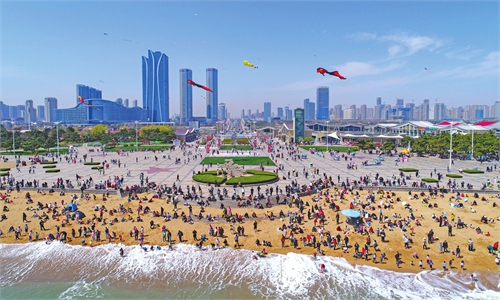Enjoy off-the-beaten-path tour
Inbound tourism boom drives up demand for foreign language tour guides in China

Foreign tourists enjoy the scenery on a bamboo raft on Yulong River in Yangshuo county, Southwest China's Guangxi Zhuang Autonomous Region, on July 15, 2023. Photo: VCG
"Inbound tourism is booming this year..." This is the sentiment expressed by a foreign language tour guide surnamed Li, as he enters his eighth year in the tourism industry.
When he joined the industry in 2016, there were four Spanish-speaking guides in Chengdu, Southwest China's Sichuan Province, including him.
However, with the tourism industry in a slump for three years (2020-23) due to the COVID-19 pandemic, he switched to working as a translator for a construction company.
In early last year, as the pandemic ebbed, he returned to the tourism industry and became the only full-time Spanish-speaking tour guide in Chengdu.
Over the past year, he has witnessed the slow recovery of inbound tourism, followed by an explosive growth starting in March of this year.
This growth curve is largely attributed to a series of macro policies driving the industry.
Last November, the Consular Department of the Ministry of Foreign Affairs issued an announcement simplifying visa procedures for foreigners coming to China, together with several other government departments putting forward measures to facilitate cross-country exchanges.
China also announced unilateral and reciprocal visa exemptions with multiple countries, expanding the circle of visa-free "friends of China."
China has implemented unilateral visa-free policies for countries including Australia, New Zealand, Poland, France, Germany, Italy, the Netherlands, Spain, Switzerland, Ireland and Hungary. China has also reciprocally waived visa requirements with Thailand, Singapore, Malaysia, Georgia and other countries.
Soaring demand
With the end of the COVID-19 pandemic and the promotion of visa-free policies, more and more foreign tourists are choosing China as their next travel destination.
Li's schedule from March to the end of October is fully booked - at least 25 days of group tours per month, from 8 am to 4 pm every day, with lots of walking, and even more if he visits the popular Chengdu Research Base of Giant Panda Breeding.
Despite Li arranging a "devilish schedule" for himself, many foreign tour groups still struggle to find a foreign language guide.
In response, he collaborated with a travel agency to train junior students majoring in Spanish at some Sichuan foreign language colleges, in order to increase the number of Spanish-speaking guides.
According to media outlets, foreign language guides are in short supply, with some guides for non-common languages earning daily wages exceeding one thousand yuan ($137.6).
Many travel agencies have put the recruitment of foreign language tour guides on their agenda.
Wei Xiaoqing, from Beijing Tourism Group, told the Global Times that their company currently has English and other non-common language guides, with salaries ranging from 1000 to 1500 yuan per day, based on experience and abilities.
Wu Wei, the general manager of Far East Travel Agency, said that since August last year, China has implemented visa-free group visas for Russia, resulting in a significant increase in Russian tourists entering the country, especially from last December.
It is expected that the number of Russian tourists will reach its peak by July, Wu predicted.
"Currently, the agency has over sixty Russian language tour guides, but there is still a shortage of guides, especially with the continuous growth of tourists in July," Wu said.
Considering this, they are planning to recruit more Russian-speaking professional guides, and the payment for those guides range from 500 to 1000 yuan per day, Wu noted.
More intl friends anticipated
According to the Xinhua News Agency, the China Tourism Academy released an annual report on Tuesday, which shows that the development trend of China's inbound tourism market in 2024 continues to improve. In an optimistic scenario, the inbound market for foreign visitors in 2024 is expected to recover to 80 percent of the level in 2019.
The latest data released by the National Immigration Administration shows that in the first quarter of this year, the number of foreigners entering China increased more than threefold year-on-year; a total of 466,000 visas were issued to foreigners, an increase of 118.8 percent year-on-year; 1.99 million foreigners entered China without a visa, an increase of 266.1 percent year-on-year.
Data from the major Chinese travel platform Trip.com on Tuesday shows that travel orders from Australia, New Zealand and Poland into China during the summer holiday increased by 40 percent compared with last year after the visa exemption policy was issued.

Chengdu-based Chinese tour guide surnamed Li and his foreign clients Photo: Courtesy of Li
Welcome to China
While Beijing, Shanghai and Hong Kong are well-known cities to many foreigners, other Chinese cities like Chengdu remain mysterious and are waiting for more international friends to discover their hidden surprises.
Li said that although many young foreigners learned about Sichuan Opera face-changing through overseas video platforms like TikTok and YouTube before coming to Chengdu, many elderly tourists still thought Chengdu was a small county with nothing to see but pandas.
Usually, the classic route for foreign tourists traveling to China for the first time is Beijing-Shanghai-Xi'an-Guilin-Hong Kong. The Terracotta Warriors in Xi'an have such a great reputation overseas that many tourists go to Xi'an first and then take a three-hour high-speed train to Chengdu thanks to the travel convenience across China.
"When foreign tourists arrive at Chengdu, many are amazed by the large train station, and often ask how many people live in Chengdu," Li revealed.
Among Li's clients, 90 percent are small groups of 2-5 people. The vast majority of clients are elderly people with some economic means and more leisure time. Instead of the intense itinerary, they prefer to slow down and savor China, Li said.
At the end of February, Li provided service for an elderly Spanish couple. The itinerary for this trip was designed by the couple, covering Harbin, Lijiang, Dali, and Shangri-La - cities that are "off the beat and track" for foreign tourists.
Before coming to Sichuan, the elderly couple's expectation was to romantically stroll hand in hand and paddle on the lake in the bamboo sea. They realized their dream. In a photo taken by Li, the Spanish man smiles from ear to ear on the bamboo raft.
At the end of April, Li hosted an elderly man from Mexico who insisted on dining only at Michelin-starred restaurants, spending a minimum of 500 yuan per person per meal. But the Mexican later surprisingly developed a newfound appreciation for Sichuan cuisine after dining at a local restaurant.
It is expected with the visa-free policies and more preferential measures, more international tourists will come and enjoy the old and inclusive oriental country.


